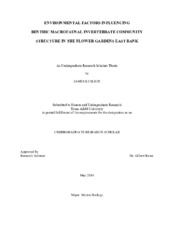| dc.description.abstract | The Flower Garden Banks consist of two salt domes raised above the continental shelf in the Gulf of Mexico roughly 190 km southeast of Galveston, Texas. With mean annual temperature variations of 18 to 32°C and relatively low-turbidity water, the shallower portions of both banks provide ideal substrates for scleractinian coral growth, resulting in the formation of the two northernmost coral reefs in the continental U.S (Bright et al., 1984; Teague et al., 2013). Factors affecting macroinfaunal organism communities within the shallowest portions of these banks have so far been neglected, with the nearest assessments being conducted by Yingst and Rhoads in waters over 90 m deep and adjacent to the Banks, not within the Bank tops (1985).
The objectives of this study were twofold: to determine if there are statistically significant differences in composition between the polychaete communities of the coastal northwestern Gulf of Mexico and the East Flower Garden Bank (EFGB), and to look for correlations between the environmental parameters of percent carbonate content, particulate organic carbon (POC) content, and sediment grain size, and the community parameters of biomass, density, species richness, species evenness, and diversity of all macroinfaunal invertebrates at a depth of ~25 meters in the EFGB.
Eight box core samples were taken off the coast of Louisiana from August 21-September 9, 1978, and box core samples were taken from the EFGB on August 28-29, 2013. There was no overlap in species composition between the Louisiana samples and the EFGB samples, and the Louisiana samples were more diverse in general. Amphipod and isopod crustaceans dominated the EFGB macrofauna numerically in most samples, but polychaete worms comprised the largest percentage of biomass in all EFGB samples.
Mean sediment grain size was positively and significantly correlated with species count, Margalef’s richness, and biomass. Particulate organic carbon content was positively and significantly correlated with every diversity measurement except species count and individual density. Sediment carbonate content was not significantly correlated with any biotic variable. No significant correlations were detected between the environmental variables. | en |


